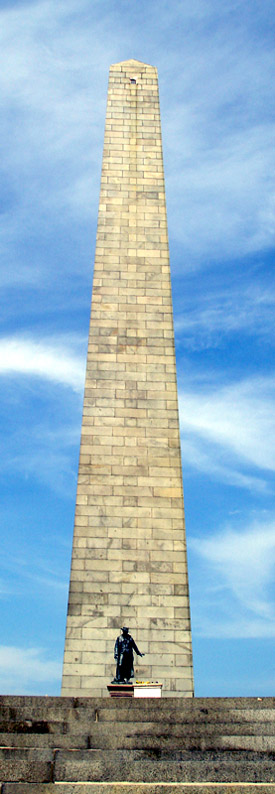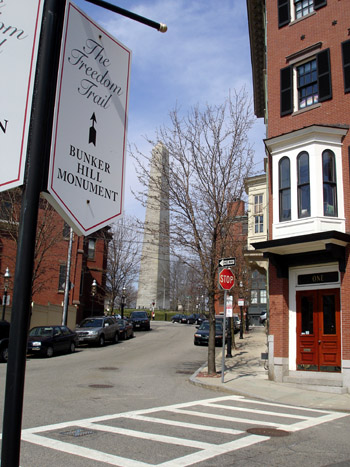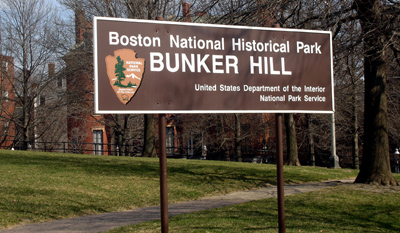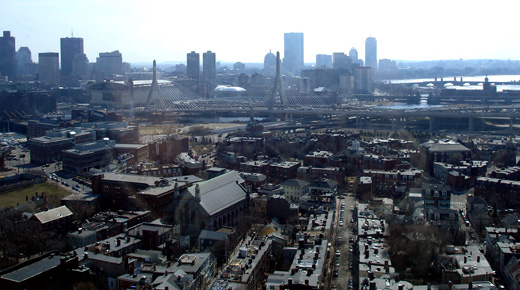
A historical climb visiting Bunker Hill
BOSTON — Past an iron gate and up several granite steps embedded into the grassy hillside sits the Bunker Hill Monument, towering over historic Charlestown as both a reminder and a celebration of the determination and courage of the American people.
At the top of the steps, two giant pillars and a heavy iron door welcome visitors, serving as the portal that unlocks the history of the brave men who sacrificed everything for life, liberty and the pursuit of happiness.
 The site houses the monument that sits on approximately five acres of land. There is also a museum located across the street from the monument grounds that is jointly operated by the National Park Service and the Charlestown Historical Society.
The site houses the monument that sits on approximately five acres of land. There is also a museum located across the street from the monument grounds that is jointly operated by the National Park Service and the Charlestown Historical Society.
On any given day, the site is busy with tourists as well as locals who frequent the grounds to walk their dogs or sit on the wooden benches to read a good book.
But it was busy in a different sort of way on June 17, 1775. On that day, a group of determined American soldiers confronted the experienced British army in a battle that would prove the colonists a force to be reckoned with.
Between 2,500 and 4,000 New Englanders positioned themselves on Bunker Hill, a dominant hill in Charlestown crucial to the British occupation of Boston.
Although the British won control over the Charlestown peninsula after the battle, they still suffered devastating losses and were shaken up by the inexperienced, yet resolved, colonists.
To commemorate the bravery of the colonial soldiers, the Bunker Hill monument was erected in 1843, a project initiated by the Bunker Hill Monument Association. After 16 long years of overcoming obstacles, such as lack of funding, the monument was completed. Today, the moment and its grounds are part of the Boston National Historical Park.
Standing 221 feet above the ground, the granite structure has a total of 294 steps, the equivalent of 22 stories. Adjacent to the actual structure is an air-conditioned welcome center, complete with exhibits, restrooms, and helpful park rangers that are ready to help bring the battle of Bunker Hill to life.
“Not only do I greet people, give them information and count them as they come in, but [I help to] interpret the site, and, ultimately, my job as interpreter is to…be the catalyst between the visitor and the resource,” said Emily Prigot, a park ranger at the monument for 16 years. “We hope they will become stewards of the resource – [that] they will want to take care of it. That doesn’t happen by waving a magic wand. So it’s up to us to come up with talks that will inspire [people], [and] make them care.”
According to Prigot, her job also includes warning people about the health hazards to climbing the tall monument. Although not necessary to enjoy the site, climbing the winding staircase is a way for visitors to capture the full magnitude of the monument’s significance and height.
Once at the top, the panoramic view makes the strenuous climb worth every step. It provides visitors with a unique view of the Boston skyline, as well as the Charleston Bridge and the Charleston Navy Yard.
Because of the granite blocks, the temperature inside the actual monument is an amplification of temperature outside. During the fall and winter, visitors should bundle up, as they will face frigid temperatures. However, during the summer, the heat may cause unbearable discomfort, and water bottles are a necessary carry-on item.
 |
Visitors can depend on the Freedom Trail to lead them to the Bunker Hill Monument (Photo by Christine Dominguez). |
Visitors should not underestimate the climb to the top. According to Prigot, the climb is strenuous, and visitors who are claustrophobic, afraid of heights, or have health problems that may be triggered by extraneous physical activity should reconsider climbing the monument.
Visiting Bunker Hill is more than just the climb. The Bunker Hill grounds illustrate a unique, hands-on historical perspective on the United States that draws thousands of visitors a year.
Typically, there are three main seasons: spring, summer and fall, each of which attract their own unique groups of people. The springtime, for example, brings in a large amount of students on educational fieldtrips. The site is so popular that several hundred people may show up at one time, which is why some visitors choose to make reservations beforehand.
| The Bunker Hill Monument is one of Charlestown’s most popular sites (Photo by Christine Dominguez). |
 |
Its popularity is a result of the hard work of the park rangers, who see themselves as ambassadors for the site, making the historical context relatable to today’s general public.
“The universal concept is that [visitors] see how they are connected [to the monument], because if you look at it in one crass way, this is about a bunch of people over 200 years ago,” said Prigot. “And so a good interpreter will forge that connection, and we have competencies that we try to meet as interpreters. We [at] the National Park Service [have] almost like a certification process where we have to meet certain guidelines.”
Starting in May 2006, the monument and the museum will both be undergoing renovations and they will be closed until Aug. 27, 2006. The monument will be repointed, a process that hasn’t been done since its construction in 1843, and a new outdoor lighting system similar to that of the Washington Monument will be installed.
The welcome center will be repainted and its bathrooms will be reconstructed. New exhibits will be brought in to the monument’s museum, which is being completely transformed.
 |
| Boston from the monument (Photo by Christine Dominguez). |
If You Go
- Admission Price: Free.
- Hours: Open daily from 9 a.m. to 5 p.m.
- Closures: Thanksgiving, Christmas and New Year’s Day.
- Closed for renovation: May 1 – Aug. 27, 2006.
- Facilities: restrooms, benches, brochures and information.
- Food: There are no food facilities on site. However, there are several restaurants within walking distance of the monument.
- Transportation: Visitors can follow the Freedom Trail to Monument Square in Charlestown, Mass. or choose to take a taxi.
- For more information, call 617-242-5641 or visit http://www.nps.gov/bost.

Comments are Closed